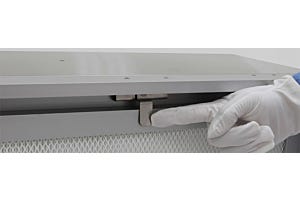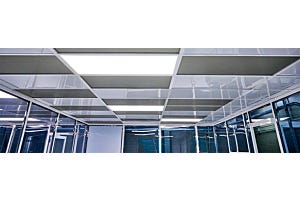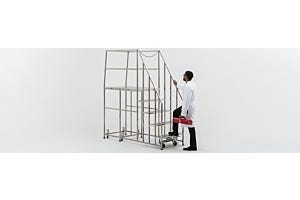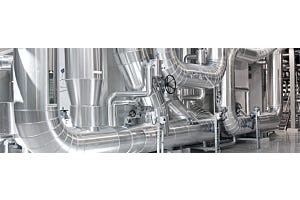What is a Cleanroom?
A cleanroom is an environment that must maintain a specific concentration and size of airborne particles per cubic meter. To achieve and maintain a specific cleanliness classification, the room is supplied with a continuous supply of HEPA filtered air.
What is a Clean Room Used For?
Electronics
- Computer component and package assembly
- Circuit board manufacturing
- Wafer and chip manufacturing
- Displays, optics, and thin film manufacturing
- Hard drive manufacturing and data recovery
- PCB/SMT manufacturing
- Satellite and spacecraft assemblies
- Precision lasers and optics
Hospitals, Biotech, Lifesciences
- Hospital, laboratory, and veterinary pharmacies
- Pharmaceutical packaging and preparation
- Sterile and non-sterile compounding
- RNA / MRNA research
- Gene and T-cell
- Hazardous and non-hazardous containment
- Isolation wards
- Medical devices and tooling
Food and Agriculture
- Food, beverage, and spirits manufacturing
- Agriculture, cultivation, germination, and micropropagation
- Genetics research
- Mycology
Manufacturing Cleanroom-Ready Products
- Sterile packaged items
- Cleanroom rated garments and PPE
- Cleanroom gloves and wipes
- Single-use cleanroom items
What is a Cleanroom Rating?
ISO ratings are developed by the International Standards Organization. As a worldwide federation of national standards, the organization works alongside internal organizations, governmental, and non-governmental agencies to create technical performance standards and suggested practices.
What is an ISO 14644-1 Cleanroom?
ISO 14644-1:2015 is deemed a golden standard for constructing particle-controlled environments. ISO documentation provides a blueprint for structural design, testing, and calibration imperative to achieving an ISO-rated cleanroom environment. Based on the cleanroom rating and task at hand, a cleanroom may require additional features and enhanced enclosures that can provide isolation, containment, or safe exfiltration of potential hazards, chemicals, aerosols, and viable or non-viable particulates.
ISO requirements address a wide range of contamination control and risk-mitigating strategies that may include:
- Health and safety requirements;
- Compatibility with cleaning agents and techniques
- Cleanability
- Biocontamination
- Specific requirements of equipment and materials for processes and products
- Design details of equipment
Why are ISO Cleanroom Ratings Important?
Repeatability, consistency, benchmarking, and application-specific compliance are the most common reasons for seeking ISO-rated cleanrooms and enclosures. While ISO standards are non-binding suggestions, enforcement organizations such as the FDA lean on these standards as indicators of compliance.
In most cases, achieving an ISO-rated environment is a method of quality assurance and protection. Maintaining a strict ISO rating ensures that if new contamination sources arise and air quality declines, a facility can more easily detect rising contamination levels after comparing them to baseline levels. Additionally, ISO standards provide organizations with standard performance benchmarks when designing and constructing a room appropriate for their application.
In more sophisticated systems with active monitoring and automated alarms, cleanroom operators can be automatically notified of increased particulate levels or changes in humidity or temperature.
Most cleanroom enclosures are not hermetically sealed, meaning the walls and ceilings do not form an airtight structure. However, in some pharmaceutical and research applications, the entire structure is sealed to prevent the escape of hazardous, noxious, biohazardous, or carcinogenic compounds.
What Are the Different ISO Cleanroom Classes?
| Airborne Particulate Cleanliness Class Comparison | ||
| ISO 14644-1 | FEDERAL STANDARD 209E | |
| ISO Class | English | Metric |
| ISO 1 | — | — |
| ISO 2 | — | — |
| ISO 3 | 1 | M1.5 |
| ISO 4 | 10 | M2.5 |
| ISO 5 | 100 | M3.5 |
| ISO 6 | 1,000 | M4.5 |
| ISO 7 | 10,000 | M5.5 |
| ISO 8 | 100,000 | M6.5 |
| ISO 9 | — | — |
Cleanrooms are classified by stringent requirements that define a cleanroom "rating". Depending on the number of particles per cubic meter of air, a cleanroom is assigned a rating between ISO Class 1 through ISO Class 9. In the US, cleanrooms are ordinarily rated between ISO Class 3 - ISO Class 8. The lower the cleanroom class, the cleaner the environment.
Uncontrolled environments may contain millions, if not billions, of particles per cubic meter. In comparison to a typical office environment, an ISO 8 cleanroom reduces airborne particulate by a factor of 10, thus each cubic meter of air sampled must contain fewer than 100,000 particles. For each jump in ISO class, air quality increases by an additional factor of 10.
What are the standard cleanroom classes defined by ISO cleanroom ratings?
- ISO Class 3
- ISO Class 4
- ISO Class 5
- ISO Class 6
- ISO Class 7
- ISO Class 8
Read More: ISO ISO 14644-1 vs Fed. Class Cleanroom Ratings
What is a Class 1 Cleanroom?
Over 20 years after some of the first commercially-ready ISO Class 1 enclosures were constructed, these environments remain rare for the typical cleanroom production environment. The majority of cleanroom-produced components and materials do not require such stringent environmental controls.
ISO 1 cleanroom environments constitute one of the cleanest human-made structures on Eearth. Up until the early 2000s, sub-ISO Class 2 cleanrooms were typically not required because component sizes had not yet achieved nanoscale units.
ISO 1-rated cleanrooms must contain no more than 10 particles per cubic meter (0.1 microns or smaller). Granted, ISO cleanroom validation works on an average of particle counts measured from numerous sampling points.
ISO 1 cleanrooms must exchange an extraordinary amount of airflow, anywhere from 300 - 600 air changes per hour. Unless maintenance or servicing is required, cleanrooms maintain a 24-hour operating cycle to maintain continuous positive pressure, even when the room is not occupied.
| AIRBORNE PARTICULATE CLEANLINESS CLASSES (BY CUBIC METER) | ||||||
| Class | Number of Particles Per Cubic Meter by Micrometer Size | |||||
| — | 0.1 micron | 0.2 micron | 0.3 micron | 0.5 micron | 1 micron | 5 microns |
| ISO1 | 10 | 2 | — | — | — | — |
| ISO2 | 100 | 24 | 10 | 4 | — | — |
| ISO3 | 1,000 | 237 | 102 | 35 | 8 | — |
| ISO4 | 10,000 | 2,370 | 1,020 | 352 | 83 | — |
| ISO5 | 100,000 | 23,700 | 10,200 | 3,520 | 832 | 29 |
| ISO6 | 1,000,000 | 237,000 | 102,000 | 35,200 | 8,320 | 293 |
| ISO7 | — | — | — | 352,000 | 83,200 | 2,930 |
| ISO8 | — | — | — | 3,520,000 | 832,000 | 29,300 |
| ISO9 | — | — | — | 35,200,000 | 8,320,000 | 293,000 |
ISO 1 Cleanroom Requirements:
- Less than or equal to 10 particles (0.1 μm) per cubic meter of air
- Average airflow velocity of 0.305 – 0.508 meters/second (or 60 – 100 ft/min)
- Air changes per hour: 360 – 600
- Fan/filter unit (FFU) coverage of 80 – 100%
- Test particle count every 6 months, and airflow and air-pressure differential every 12 months
ISO 2 Cleanroom Requirements
- ISO 2 cleanrooms allow no more than 100 particles (0.1 μm) per cubic meter
- Average airflow velocity of 0.305 – 0.457 meters/second (or 60 – 90 ft/min)
- Air changes per hour: 360 – 540
- Fan/filter unit (FFU) coverage of 60 – 100%
- ULPA filters required
- Test particle count every 6 months; airflow and air-pressure differential every 12 months
What is an ISO 3 Cleanroom? | ISO 3 | FED Class 1 Equivalent
ISO 3 cleanrooms are typical for aerospace, satellite, and nanofabrication environments where even the tiniest particles can compromise, degrade, diminish shelf life, or cause early and latent stage failures.
For satellite production and space exploration vehicles, an ISO 3 cleanrooms reduce the likeliness of spacecraft harboring bacteria and microorganisms that could invade and proliferate within extraterrestrial destinations.
What is an ISO 4 Cleanroom? | ISO 4 | FED Class 10
ISO Class 4 environments cater to extremely clean applications such as electronics manufacturing, thin-film materials, displays, and optics. ISO 4 cleanrooms are ideally free of virtually any organic material.
ISO Class 4 Cleanroom Requirements
- Equivalent to FED-STD-209E: Class 10
- Up to 10,000 0.1-μm sized particles per cubic meter
- Average airflow velocity of 0.254 – 0.457 meters/second (or 50 – 90 ft/min)
- Air changes per hour: 300 – 540
- Fan/filter unit (FFU) coverage of 50 – 90%
- ULPA Filters required
- Test particle count every 6 months; airflow and air-pressure differential every 12 months
What is an ISO 5 Cleanroom? | ISO 5 | FED Class 100
ISO Class 5 cleanrooms are common requirements for cell culture, DNA/RNA amplification, microbiology research, and/or sterile/non-sterile pharmaceutical compounding. In most cases, ISO 5 air quality is only required where products are exposed to the air or surfaces. Therefore, a cleanroom with a laminar flow hood or biological safety cabinet typically serves as a "cleanroom within a cleanroom".
ISO Class 5 Cleanroom Requirements
- Equivalent to FED-STD-209E: Class 100
- Up to 100,000 0.1-μm-sized particles per cubic meter of air
- Average airflow velocity of 0.203 – 0.406 meters/second (or 40 – 80 ft/min)
- Air changes per hour: 240 – 480
- Fan/filter unit (FFU) coverage of 35 – 70%
- Test particle count every 6 months, and airflow and air-pressure differential every 12 months
ISO 5 Cleanrooms for Pharmaceutical Compounding
ISO Class 5 air is considered the working standard for sterile and non-sterile compounding when preparing single-dose vial preparation, IV bags, and syringes. ISO Class 5 air quality is required in the direct compounding area and must contain less than 100,00 particles per cubic meter.
Related: Terra USP-Rated Cleanroom Designs (ISO 5 - ISO 7)
USP-rated cleanrooms for sterile compounding include ISO Class 5 in primary work areas, as well as ISO Class 7 buffer rooms to facilitate a positive pressure air delivery and maintain acute control over inside pressure differentials.
Related: USP Compounding Cleanroom Construction and Control Systems
ISO 5 Cleanrooms for IVF Therapies
Over recent decades, researchers have continued to identify links between air quality and laboratory outcomes. As one example, a 2015 study demonstrated an improvement in embryo quality and clinical pregnancy rate after a facility upgraded their cleanroom from a class 1000 (ISO 6) to a class 100 (ISO 5).
ISO 5 Cleanrooms for Micropropagation & Cell Culture
ISO 5 air is required for preventing contamination in cell cultivation, micropropagation, and bacterial biofilm research. Because these environments are often environmentally stable and abundant with moisture, growth mediums are increasingly susceptible to cross-contamination. ISO-rated HEPA filters prevent microscopic spores, bacteria, or pathogens from circulating throughout the lab and infecting other cultures.
ISO Class 5 Microenvironment
ISO 5 laminar flow hoods are miniaturized workstation enclosures that enable clean manipulations within a microenvironment.
What is an ISO 6 Cleanroom? | ISO 6 | FED Class 1000
ISO 6 environments are considered high-performance cleanroom systems with air quality suitable for preparing particulate-sensitive products, medical devices, non-sterile or some terminally sterilized products. ISO 6 cleanrooms are designed with a cascading air pressure system achieved by adjacent ISO 7 and ISO 8 partitions for gowning and process support. Airlocks provide air pressure equalization for smaller footprint installations where internal pressure significantly differs from the outside air.
ISO 6 Cleanroom Requirements
- Equivalent to FED-STD-209E: Class 1000 (Class 1K)
- Up to 1,000,000 0.1-μm sized particles per cubic meter
- Average airflow velocity of 0.127 – 0.203 meters/second (or 25 – 40 ft/min)
- Air changes per hour: 150 – 240
- Fan/filter unit (FFU) coverage of 25 – 40%
- Test particle count, airflow, and air-pressure differential every 12 months
What is a ISO 7 Cleanroom? | ISO 7 | FED Class 10000
ISO 7 cleanrooms serve as either primary manufacturing environments or secondary containment rooms to support gowning, staging, or cleaning and processing stations.
The popularity of ISO 7 cleanroom designs is in part due to their extremely clean performance and compliance ratings, but also because these systems can achieve operating pressure with only a single airlock or ISO 8 rated partition for gowning and entry.
ISO 7 cleanrooms are typical for electronics assembly, PCB/SMT manufacturing, medical device manufacturing, and the production of other microelectronic assemblies and components.
ISO 7 Cleanroom Requirements
- Equivalent to FED-STD-209E: Class 10000 (10K)
- Up to 352,000 0.5-μm sized particles per cubic meter
- Average airflow velocity of 0.051 – 0.076 meters/second (or 10 – 15 ft/min)
- Air changes per hour: 60 – 90
- Fan/filter unit (FFU) coverage of 15 – 20%
- Test particle count, airflow, and air-pressure differential every 12 months
GMP Compliant ISO 7 Cleanroom Requirements
- According to FDA GMP standards, if a restricted access barrier is used (e.g., a glove box), the surrounding area should, at a minimum, meet ISO 7 standards under dynamic conditions.
- It's recommended that terminally sterilized drugs be produced in ISO 8 or better air quality as determined under dynamic conditions.
What is an ISO 8 Cleanroom? | ISO 8 | FED Class 100,000
- Equivalent to FED-STD-209E: Class 100000 (100K)
- Up to 3,520,000 0.5-μm sized particles per cubic meter
- Average airflow velocity of 0.005 – 0.041 meters/second (or 1 – 8 ft/min)
- Air changes per hour: 5 – 48
- Fan/filter unit (FFU) coverage of 5 – 15%
- Test particle count, airflow, and air-pressure differential every 12 months
What are ISO 8 Cleanrooms Used For?
ISO Class 8 cleanrooms are adequate for a wide range of manufacturing processes including packaging, powder handling, OEM assembly, storage of packaged goods, and localized process containment or isolation.
Types of Cleanrooms
Hardwall Cleanrooms
The major advantages of hardwall cleanrooms over softwall alternatives include easy cleaning, reliable temperature/humidity control, predictable pressure values, and more efficient air delivery with less leakage.
Modular Softwall Cleanrooms
Modular softwall cleanrooms are common for environments where precise control over room-to-room pressure is unnecessary. The advantages of softwall cleanroom construction are ease of construction, mobility, and easy relocation. Softwall cleanrooms feature strip curtains that affix to freestanding overhead beams. Overhead fan filter units are mounted to a ceiling-integrated t-grid system.
Custom Softwall Cleanrooms
Custom softwall cleanrooms are ideal for environments with unique equipment geometries or large footprint equipment assemblies such as printing applications, automated conveyor systems, machine enclosures, and other machine-oriented assembly processes.
How Much Does A Softwall Cleanroom Cost?
Softwall cleanroom prices range between $5K - $10K depending on the size, ceiling height, number of fan filter units, and type of curtain material.
Preconfigured Valuline Softwall Cleanrooms offer a cost-effective, ready-to-ship solution. Valueline cleanrooms are an economical choice for achieving ISO-rated air quality without any intensive design, engineering, or construction expertise. The modular frame and panel structure accommodate equipment and facility demands specific to unique floor plan requirements.
Mobile Cleanrooms
When mounted on mobile casters, the containment can be easily moved around the production floor to support equipment repair, particulate control, or isolate clean processes from dirtier nearby spaces.
For mobile containment applications, Terra's CleanBooth is capable of supporting ISO 6 - ISO 8 air quality. Mobile cleanroom booths are ideal for operations with probe stations, screen printers, and other free-standing process equipment, as well as benchtop kitting or assembly.
Do I Need a Softwall Cleanroom or Hardwall Cleanroom?
Because a softwall cleanroom does not have a rigid wall structure, clean air flows down from the fan filter units mounted in the ceiling grid and exits through or underneath the curtain strips. The design is effective for creating a significant reduction in airborne particulate but less effective in maintaining humidity and pressure differentials. While a softwall cleanroom can achieve ISO ratings as low as ISO Class 5, facilities that require ISO 7 or cleaner will usually opt for hardwall construction. Air leakage and poor pressure control make achieving extraordinarily low particulate levels in a softwall cleanroom both inefficient and costly.
Need Help with Cleanroom Construction or Outfitting? Terra Universal's Value Advantage
Have a technical question that requires a prompt and helpful response?
Contact a Terra cleanroom specialist via phone, live chat, or email.
Terra Universal offers end-to-end engineering, construction, outfitting, certification, and testing for a wide variety of controlled environments including cleanrooms, laminar flow hoods, glove box isolators, biosafety cabinets, and lab equipment. Terra Universal's integrated design and manufacturing know-how allow cleanroom customization for a specific task or a total production environment.
Facility Optimization — Create the production environment you require without the expense or disruption of a major fab upgrade! Expand or reconfigure as your requirements change.
Unsurpassed Cleanliness — Filtration and ventilation efficiency are required to meet the most rigorous cleanliness standards. Independently certified Class 1.
Hardwall, Softwall, and AirLock Designs — A style for every requirement, schedule, and budget!
Comprehensive Environmental Controls — Over particulates, humidity, temperature, and ESD (electrostatic discharge)
Industry-leading Quality — Over 40 years of engineering and manufacturing experience provide the field-proven quality you can count on.
Certified Designs and Fabrication Techniques — Terra Universal has received independent certification as a Cleanroom Manufacturing Specialist.
Delivered to Your Production Schedule — Terra Universal understands the critical importance of timely delivery and works closely with you to accommodate tight schedules. Expanded QuickShip configurations provide a wide variety of "need it now!" cleanrooms.



















